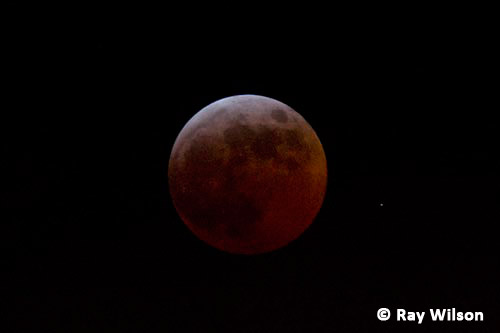
- Home
- Workshops / Tours
- Diary / Blog
- Galleries
- Foreign Trips
- Australia's Wet Tropics 2015
- Australia's Top End 2015
- SW Australia 2015
- Switzerland 2015
- Andalucia 2015
- Belize 2015
- Australia 2014
- Switzerland 2014
- Belize 2014
- Bahama Islands 2014
- Switzerland 2013
- Ecuador 2012-2013
- Florida 2011-2012
- Vancouver Island 2011
- Australia 2010
- Peru 2008
- Bulgaria 2007
- Lesvos 2006
- California 2006
- New Zealand 2005
- Extremadura 2005
- Goa, India 2004
- The Gambia 2003
Lunar Eclipse - 3rd March 2007
Miraculously, we had a perfectly clear sky during the total eclipse of the moon on Saturday night.
Total lunar eclipses are rarer than solar eclipses, but since they are generally visible over half of the Earth's surface (compared to a Solar eclipse's narrow corridor only 100km wide) they are viewable from any single location once every 3 years or so. Solar eclipse only occur at the same point once every 375years! Lunar eclipses also last a lot longer. Totality can last up to a maximum of 100 minutes compared to the 3 minutes you get for a solar eclipse.

Sequential composite taken as the moon enters the earth's shadow. The 4 photos were taken over a 30 minute period.
During totality, the moon is lit purely by light scattered into the Earth's shadow (or 'umbra') by the Earth's atmosphere. The colour is dependent on the amount of dust present in the atmosphere. Dust particles cause refraction of the Sun's light, and since red light has a longer wavelength than blue light, only the red portion of the spectrum is bent far enough into the umbra to light the moon. Higher dust levels (eg. after a volcanic eruption) cause more scattering of the light and creates a deeper red colour.

Total eclipse of the moon
The low levels of light coming from the eclipsed moon create difficulties for photography. At totality, even when using ISO1600, I was having to take exposures of 1/10th of a second at f5.6, making it very difficult to get a sharp photo when using a 600mm lens with a 1.4x converter attached.
Ray Wilson owns the copyright of all images on this site.
They may not be used or copied in any form without prior written permission.
raywilsonphotography@googlemail.com